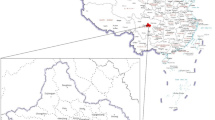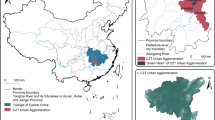Abstract
Research on the carbon budget and zoning for carbon compensation in major functional zones (MFZs) is important for formulating strategies for low-carbon development for each functional zone, promoting the collaborative governance of the regional ecological environment, and achieving high-quality development. Such work can also contribute to achieving peak emissions and carbon neutrality. This paper constructs a theoretical framework for the carbon budget and carbon compensation from the perspective of the MFZ, uses 157 county-level units of the Beijing-Tianjin-Hebei urban agglomeration (BTHUA) as the study area, and introduces the concentration index, normalized revealed comparative advantage index, and Self Organizing Mapping-K-means (SOM-K-means) model to examine spatio-temporal variations in the carbon budget and carbon compensation zoning for the BTHUA from the perspective of MFZs. The authors propose a scheme for the spatial minimization of carbon emissions as oriented by low-carbon development. The results show that: (1) From 2000 to 2017, the carbon budget exhibited an upward trend of volatility, its centralization index was higher than the “warning line” of 0.4, and large regional differences in it were noted on the whole. (2) There were significant regional differences in the carbon budget, and carbon emissions exhibited a core-periphery spatial pattern, with a high-value center at Beijing-Tianjin-Tangshan that gradually decreased as it moved outward. However, the spatial pattern of carbon absorption tended to be stable, showing an inverted “U-shaped” pattern. It was high in the east, north, and west, and was low in the middle and the south. (3) The carbon budget was consistent with the strategic positioning of the MFZ, and the optimized development zone and key development zone were the main pressure-bearing areas for carbon emissions, while the key ecological functional zone was the dominant zone of carbon absorption. The difference in the centralization index of carbon absorption among the functional zones was smaller than that in the centralization index of carbon emissions. (4) There were 53 payment areas, 64 balanced areas, and 40 obtaining areas in the study area. Nine types of carbon compensation zones were finally formed in light of the strategic objectives of the MFZ, and directions and strategies for low-carbon development are proposed for each type. (5) It is important to strengthen research on the carbon balance and horizontal carbon compensation at a microscopic scale, enrich the theoretical framework of regional carbon compensation, integrate it into the carbon trading market, and explore diversified paths for achieving peak emissions and carbon neutrality.
Similar content being viewed by others
References
Allen M R, Frame D J, Huntingford C et al., 2009. Warming caused by cumulative carbon emissions towards the trillionth tonne. Nature, 458(7242): 1163–1166.
Balassa B L, 1965. Trade liberalisation and “revealed” comparative advantage. Manchester School, 33(2): 99–123.
Chai L H, Zhu H Y, 2016. Evolution trend of regional centralization of grain production in China. Journal of Natural Resources, 31(6): 908–919. (in Chinese)
Chen J D, Gao M, Cheng S L et al., 2020. County-level CO2 emissions and sequestration in China during 1997–2017. Scientific Data, 7(1). doi: https://doi.org/10.1038/s41597-020-00736-3.
China Environmental Culture Promotion Association (CECPA), 2008. The First Report of “Research on China Carbon Balance Trading Framework” issued in Beijing [2008-11-06]. http://www.zhb.gov.cn/zhxx/hjyw/200811/t20081106_130915.htm. (in Chinese)
Ding Y L, 2015. Net carbon emissions estimates and carbon offsets in rural tourism destinations from a carbon neutral perspective [D]. Nanjing: Nanjing Normal University. (in Chinese)
Fan J, 2007. The scientific foundation of major function oriented zoning in China. Acta Geographica Sinica, 62(4): 339–350. (in Chinese)
Fan J, 2013. The strategy of major function oriented zoning and the optimization of territorial development patterns. Bulletin of Chinese Academy of Sciences, 28(2): 193–206. (in Chinese)
Fan J, 2015. Draft of major function oriented zoning of China. Acta Geographica Sinica, 70(2): 186–201. (in Chinese)
Fan J S, Yu X F, Zhou L, 2018. Carbon emission efficiency growth of land use structure and its spatial correlation: A case study of Nanjing city. Geographical Research, 37(11): 2177–2192. (in Chinese)
Fang J Y, Huang Y, Zhu J L et al., 2015. Carbon budget of forest ecosystems and its driving forces. China Basic Science, 20(3): 20–25. (in Chinese)
Galik C S, Jackson R B, 2009. Risks to forest carbon offset projects in a changing climate. Forest Ecology & Management, 257(11): 2209–2216.
Hu A G, Zhou S J, 2014. Green development: Functional definition, mechanism analysis and development strategy. China Population, Resources and Environment, 24(1): 14–20. (in Chinese)
Kohonen T, 1982. Self-organized formation of topologically correct feature maps. Biological Cybernetics, 43(1): 59–69.
Lai L, 2010. Carbon emission effect of land use in China [D]. Nanjing: Nanjing University. (in Chinese)
Li B J, Zhang Q Q, 2017. Decomposition of carbon emission influence factors in Beijing-Tianjin-Hebei region and its trend in the new normal situation. Ecological Economics, 33(4): 19–24. (in Chinese)
Li L, Dong J, Xu L et al., 2019. Spatial variation of land use carbon budget and carbon compensation zoning in functional areas: A case study of Wuhan Urban Agglomeration. Journal of Natural Resources, 34(5): 1003–1015. (in Chinese)
Li Q Q, Gong M Y, Gu Q P, 2013. Study on carbon offsetting in cap-and-trade mechanism. Environmental Science & Management, 38(8): 51–55. (in Chinese)
Li Y, 2014. Study on agricultural carbon sink function and compensation mechanism [D]. Tai’an: Shandong Agricultural University. (in Chinese)
Liu Q Q, Wang S J, Zhang W Z et al., 2019. Examining the effects of income inequality on CO2 emissions: Evidence from non-spatial and spatial perspectives. Applied Energy, 236: 163–171.
Lu J Y, Huang X J, Dai L et al., 2012. Spatio-temporal scale analysis on the equality of energy consumption carbon emission distribution in China. Journal of Natural Resources, 27(12): 2006–2017. (in Chinese)
Mao H Y, 1991. Study on coordinating development of economic, social growth with population, resources and environment at county level. Acta Geographica Sinica, 46(4): 385–395. (in Chinese)
Melillo J M, Steudler P A, Aber J D et al., 2002. Soil warming and carbon-cycle feedbacks to the climate system. Science, 298(5601): 2173–2176.
Shen T H, 2013. Study on ecological forest compensation mechanism of the Chongqing reservoir area in Three Gorges [D]. Chongqing: Southwest University. (in Chinese)
Su Y X, Chen X Z, Ye Y Y et al., 2013. The characteristics and mechanisms of carbon emissions from energy consumption in China using DMSP/OLS night light imageries. Acta Geographica Sinica, 68(11): 1513–1526. (in Chinese)
Wang G, Zhang H B, Xue F et al., 2017. Relations between land use carbon budget and economic development at county level in Chengdu city. Journal of Natural Resources, 32(7): 1170–1182. (in Chinese)
Wang H, Chen C C, Pan T et al., 2014. County scale characteristics of CO2 emission’s spatial-temporal evolution in the Beijing-Tianjin-Hebei metropolitan region. Environmental Science, 35(1): 385–393. (in Chinese)
Wang L G, Ding C X, Peng J F et al., 2020. Comparison of factors affecting tourism operators’ carbon offset willingness of forest parks. Economic Geography, 40(5): 230–238. (in Chinese)
Wen L J, Zhang J J, 2015. Progress and trends of land spatial regulation, unbalanced development and spatial externalities. China Land Science, 29(7): 4–12. (in Chinese)
Xu C L, Ren J L, Gong C J, 2014. The influence of adjustment in industrial structures on carbon emissions in Shandong Province. Journal of Natural Resources, 29(2): 201–210. (in Chinese)
Yu R, Cai J N, Leung P S, 2009. The normalized revealed comparative advantage index. Annals of Regional Science, 43(1): 267–282.
Zang H K, Yang W S, Zhang J et al., 2020. Research on carbon dioxide emissions peaking in Beijing-Tianjin-Hebei city agglomeration. Environmental Engineering, 38(11): 19–24, 77. (in Chinese)
Zhang M, Lai L, Huang X J et al., 2013. The carbon emission intensity of land use conversion in different regions of China. Resources Science, 35(4): 792–799. (in Chinese)
Zhang P T, Liu S J, Zhou Z et al., 2021. Supply and demand measurement and spatio-temporal evolution of ecosystem services in Beijing-Tianjin-Hebei Region. Acta Ecologica Sinica, 41(9): 3354–3367. (in Chinese)
Zhang S F, Song Y, Li C F et al., 2015. Land cover change and spatial difference measurement of carbon budget in Hangzhou city. Urban Problems, (6): 46–53. (in Chinese)
Zhang Y J, Wang A D, Da Y B, 2014. Regional allocation of carbon emission quotas in China: Evidence from the Shapley value method. Energy Policy, 74: 454–464.
Zhao R Q, Huang X J, Chuai X W, 2016. Misunderstandings and future trends of researches on land use carbon emissions in China. China Land Science, 30(12): 83–92. (in Chinese)
Zhao R Q, Liu Y, Li Y X et al., 2015. Overview of regional carbon compensation: Mechanism, pattern and policy suggestions. Areal Research and Development, 34(5): 116–120. (in Chinese)
Zhao R Q, Liu Y, Ma L et al., 2016. County-level carbon compensation of Henan province based on carbon budget estimation. Journal of Natural Resources, 31(10): 1675–1687. (in Chinese)
Zhao R Q, Zhang S, Huang X J et al., 2014. Spatial variation of carbon budget and carbon balance zoning of Central Plains Economic Region at county-level. Acta Geographica Sinica, 69(10): 1425–1437. (in Chinese)
Zhao Y H, Li H, Liu Y et al., 2018. Identifying driving forces of CO2 emissions in Beijing-Tianjin-Hebei region from temporal and spatial angles. Resources Science, 40(1): 207–215. (in Chinese)
Zhou H, Li G M, Zhang G Y, 2010. SOM+K-means two-phase clustering algorithm and its application. Modern Electronics Technique, 33(16): 113–116. (in Chinese)
Zhou K, 2016a. Spatial-temporal differences and cluster features of environmental pollution in China. Scientia Geographica Sinica, 36(7): 989–997. (in Chinese)
Zhou K, Fan J, Liu H C, 2017. Spatiotemporal patterns and driving forces of water pollutant discharge in the Bohai Rim Region. Progress in Geography, 36(2): 171–181. (in Chinese)
Zhou K, Li H, Shen Y M, 2020. Spatiotemporal patterns and driving factors of environmental stress in Beijing-Tianjin-Hebei region: A county-level analysis. Acta Geographica Sinica, 75(9): 1934–1947. (in Chinese)
Zhou W W, 2016b. Research on factor decomposition and scenario prediction of Beijing-Tianjin- Hebei regional energy consumption carbon emission [D]. Baoding: North China Electric Power University. (in Chinese)
Author information
Authors and Affiliations
Corresponding author
Additional information
Foundation
National Natural Science Foundation of China, No.42121001, No.42130712, No.42022007; Youth Innovation Promotion Association, CAS, No.2018069
Author
Xia Siyou (1991–), PhD Candidate, specializing in energy geography and regional studies.
This paper is initially published in Acta Geographica Sinica (Chinese edition), 2022, 77(3): 679–696.
Rights and permissions
About this article
Cite this article
Xia, S., Yang, Y. Examining spatio-temporal variations in carbon budget and carbon compensation zoning in Beijing-Tianjin-Hebei urban agglomeration based on major functional zones. J. Geogr. Sci. 32, 1911–1934 (2022). https://doi.org/10.1007/s11442-022-2029-y
Received:
Accepted:
Published:
Issue Date:
DOI: https://doi.org/10.1007/s11442-022-2029-y




